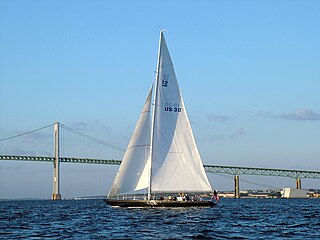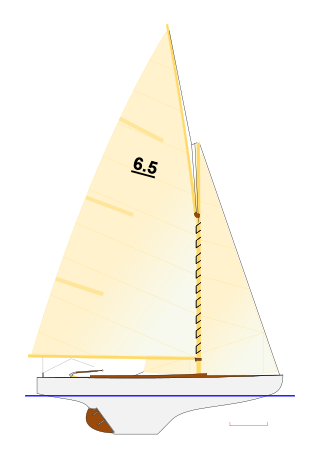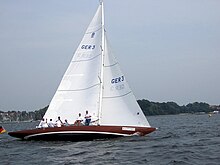
A maxi yacht usually refers to a racing yacht of at least 21 metres (70 ft) in length.

The International 2.4mR is a one-person keelboat. The class is a development class governed by the 2.4mR rule. The rule controlled by World Sailing is one of the few classes designated as an International Class. The International 2.4mR Class rule is closely related to the International 12mR class rule that was used at the America's Cup.

The International 5.5 Metre class was created to yield a racing keel boat giving a sailing experience similar to that of the International 6 Metre Class, but at a lower cost.

The 12 Metre class is a rating class for racing sailboats that are designed to the International rule. It enables fair competition between boats that rate in the class whilst retaining the freedom to experiment with the details of their designs. The designation "12 Metre" does not refer to any single measurement on the boat, and is not referencing the vessels overall length, rather, measures the sum of the components directed by the formula which governs design and construction parameters. Typically 12 Metre class boats range from 65 to 75 feet in length overall; they are most often sloop-rigged, with masts roughly 85 feet tall.

The J Class of racing yachts were built to the specifications of Nathanael Herreshoff's Universal Rule. The J Class is considered the apex of the era when the Universal Rule determined eligibility in the America's Cup.
The International Offshore Rule (IOR) was a measurement rule for racing sailboats. The IOR evolved from the Cruising Club of America (CCA) rule for racer/cruisers and the Royal Ocean Racing Club (RORC) rule.
The Universal Rule determined a yacht's eligibility to race in the America's Cup from 1914 to 1937 and for this the J-class was chosen. Boats built according to the rule reached their peak in the large J-class yachts. This Rating Rule is intended to calculate a rating for yachts, which can then be used to calculate its Time Correction Factor (T.C.F.) in order to have disparate yachts racing against each other. The first boat said to be built under the universal rule was Nathanael Greene Herreshoff's Doris built in 1905.
Thames Measurement, also known as Thames Tonnage, is a system for measuring ships and boats. It was created in 1855 as a variation of Builder's Old Measurement by the Royal Thames Yacht Club, and was designed for small vessels, such as yachts. It was originally used for calculating the port dues for yachts; the formula was also used in some early handicapping systems for yacht racing.

Skerry cruisers are yachts, usually wooden, which are constructed according to the Square metre rule. Originating from Sweden, they were historically most popular in the Baltic Sea, though some classes also saw popularity in other European countries and the United States. Skerry cruisers are construction classes, meaning that though the boats are not identical with each other, they are all built according to same formula, making them broadly comparable in size and performance. Most skerry cruisers are slender boats, with low freeboards and tall rigs.

The International Six Metre class is a class of classic racing yachts. Sixes are a construction class, meaning that the boats are not identical but are all designed to meet specific measurement formula, in this case International rule. At their heyday, Sixes were the most important international yacht racing class, and they are still raced around the world. "Six metre" in class name does not, somewhat confusingly, refer to length of the boat, but product of the formula; 6mR boats are, on average, 10–11 metres long.

A sailing yacht, is a leisure craft that uses sails as its primary means of propulsion. A yacht may be a sail or power vessel used for pleasure, cruising, or racing. There is no standard definition, so the term applies here to sailing vessels that have a cabin with amenities that accommodate overnight use. To be termed a "yacht", as opposed to a "boat", such a vessel is likely to be at least 33 feet (10 m) in length and have been judged to have good aesthetic qualities. Sailboats that do not accommodate overnight use or are smaller than 30 feet (9.1 m) are not universally called yachts. Sailing yachts in excess of 130 feet (40 m) are generally considered to be superyachts.
Ton classes are categories used to identify classes of yachts.

The International Six point Five Metre Class is a construction class, meaning that the boats are not identical but are all designed to meet specific measurement formula, in this case the French rule called Jauge chemin de fer.

The International Seven Metre Class is a construction class, meaning that the boats are not identical but are all designed to meet specific measurement formula, in this case International Rule. At their heyday, Metre Classes were the most important group of international yacht racing classes, and they are still actively raced around the world. "Seven" in class name does not, somewhat confusingly, refer to length of the boat, but product of the formula; 7 m boats are, on average, 13 meters long.

The International Ten Metre Class is a construction class, meaning that the boats are not identical but are all designed to meet specific measurement formula, in this case International Rule. At their heyday, Metre Classes were the most important group of international yacht racing classes, and they are still actively raced around the world. "Ten" in class name does not, somewhat confusingly, refer to length of the boat, but product of the formula; 10 Metre boats are, on average, 16.5 meters long.
The International Nine Metre Class is a construction class, meaning that the boats are not identical but are all designed to meet specific measurement formula, in this case International Rule. At their heyday, Metre Classes were the most important group of international yacht racing classes, and they are still actively raced around the world. "Nine" in the class name does not, somewhat confusingly, refer to the length of the boat, but the product of the formula; 9mR boats are, on average, 18 meters long.

The IYRU Fifteen Metre class yachts are constructed to the First International rule of 1907. A total of twenty 15mR yachts were built between 1907 and 1917, the four that have survived are still actively raced.

The sport of sailing involves a variety of competitive sailing formats that are sanctioned through various sailing federations and yacht clubs. Racing disciplines include matches within a fleet of sailing craft, between a pair thereof or among teams. Additionally, there are specialized competitions that include setting speed records. Racing formats include both closed courses and point-to-point contests; they may be in sheltered waters, coast-wise or on the open ocean. Most competitions are held within defined classes or ratings that either entail one type of sailing craft to ensure a contest primarily of skill or rating the sailing craft to create classifications or handicaps.

5 Metre is a development sailing class of French origin.
Handicap forms for sailing vessels in sailing races have varied throughout history, and they also vary by country, and by sailing organisation. Sailing handicap standards exist internationally, nationally, and within individual sailing clubs.


























